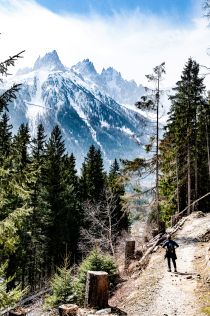Vegetation is simply an assemblage of plant species and the ground cover they provide. It is a general term denoting plant community.

Vegetation and flora are two different terms related to plant community although they are used interchangeably by many people. Vegetation is broader than the term “flora” which refers to species composition. The distinction between vegetation and flora was first made by Jules Thurmann in1849
It is a general term denoting plant community, without specific reference to any particular taxa, life forms, structure, spatial extent, or any other specific botanical or geographic characteristics.
Classification of vegetation
Many North American and European ecologists have attempted to classify vegetation based on various factors such as physiognomy, flora, ecology, etc.
According to the current US standard (adopted by the Federal Geographic Data Committee (FGDC), and originally developed by UNESCO and The Nature Conservancy), the classification is hierarchical and includes the non-floristic criteria into the upper five levels and limited floristic criteria only into the lower two levels.
In Europe, classification is often based on floristic (species) composition alone, without explicit reference to climate, phenology or growth forms. It often emphasizes indicator or diagnostic species which may distinguish one classification from another.
In the FGDC standard, the hierarchy levels, from most general to most specific, are: system, class, subclass, group, formation, alliance, and association. The lowest level, or association, is thus the most precisely defined, and incorporates the names of the dominant one to three (usually two) species of a type.
Dynamism or changes in vegetation
Dynamism in vegetation is defined primarily as changes in species composition and structure.
Temporal dynamics
Various processes or events can cause changes to the vegetation temporarily, and these changes might be abrupt or gradual.
Abrupt changes are generally referred to as disturbances; these include wildfires, high winds, landslides, floods, avalanches etc. The causes are usually external (exogenous) to the plant community—they are natural processes occurring (mostly) independently of the natural processes of the community (such as germination, growth, death, etc.). Such events can change vegetation structure and composition abruptly and for long periods, and they can affect larger areas.
Fire and wind disturbances are common occurrences throughout many vegetation types worldwide. Fire is potent enough to to destroy not only living plants but also the seeds, spores, and living meristems representing the potential next generation.
Temporal change at a slower or gradual pace comprises the ecological succession field. Succession is the relatively gradual structure and taxonomic composition change that arises as the vegetation modifies various environmental variables over time, including light, water, and nutrient levels. These modifications change the suite of species most adapted to grow, survive, and reproduce in an area, causing floristic changes. These floristic changes contribute to structural changes inherent in plant growth even in the absence of species changes (especially where plants have a large maximum size, i.e., trees), causing slow and broadly predictable changes in the vegetation.
Spatial dynamics
Generally, the vegetation will be heterogeneous in we consider larger areas. The temporal dynamics of disturbance and succession changes are increasingly unlikely to be in synchrony across any area as the size of that area increases. Different areas will be at various developmental stages. This fact interacts with inherent environmental variability (e.g., in soils, climate, topography, etc.), also a function of area. Heterogeneity in natural systems, although its scale and intensity will vary widely.
Natural vegetations
The diverse and vibrant natural vegetation plays a crucial role in maintaining the balance of our ecosystem. Discover the various plant life that blankets our world in different types of natural vegetation.
The correlation between land height and vegetation characteristics is very evident. As height varies, the climate also varies, influencing the natural vegetation. The development of vegetation is influenced by various other factors such as temperature, moisture, slope, and soil thickness.
There are five major types of natural vegetations. They include:
- Forest
- Grassland
- Tundra
- Desert
The natural vegetation of India includes:
- Tropical Evergreen Rain Forests
- Deciduous or Monsoon Type of Forests
- Dry Deciduous Forests
- Mountain Forests
- Tidal or Mangrove Forests
- Semi-Desert and Desert Vegetations
BLOGS
Microbes to detoxify our atmosphere & reduce global warming

Microbes play a vital role in reducing air pollution and global warming. Let us have a glimpse at the role of microbes in carbon sequestration and in climate change
Sustainable living

Sustainable living is a method of reducing one’s “carbon footprint”. In this life style people learn to minimize their use of Earth’s resources and reduce the personal and environmental impact. It also includes healthy organic food choices.
The Great Himalayan National Park

The great Himalayan national park, a UNESCO World Heritage Site and a biodiversity hotspot is located in Banjar sub-division of Kullu in the state of Himachal Pradesh, India. This National Park in the western part of the Himalayan Mountains is characterized by high alpine peaks, alpine meadows and riverine forests. It is part of the Himalaya biodiversity hotspot and includes twenty-five forest types.
The cultural & ecological significance of Khejri tree

Prosopis cineraria is the scientific name of this special tree which is intricately linked to the culture and traditions of Indian subcontinent since ancient times. Prosopis belongs to the pea family, Fabaceae.
Prosopis cineraria is the state tree of Rajasthan where it is known as khejri. This tree is known by various names in different parts of the country. In Western Uttar Pradesh it is known as chhonkara and inTelangana it is known as jammi. It is well-known in Madhya Pradesh& Maharashtra as Shami. Gujrati people of India knows the tree as khijro.
Sacred trees of India

Indian subcontinent has several renowned trees for worshipping which are considered sacred. The list of sacred trees of India chiefly includes Banyan tree and Peepal